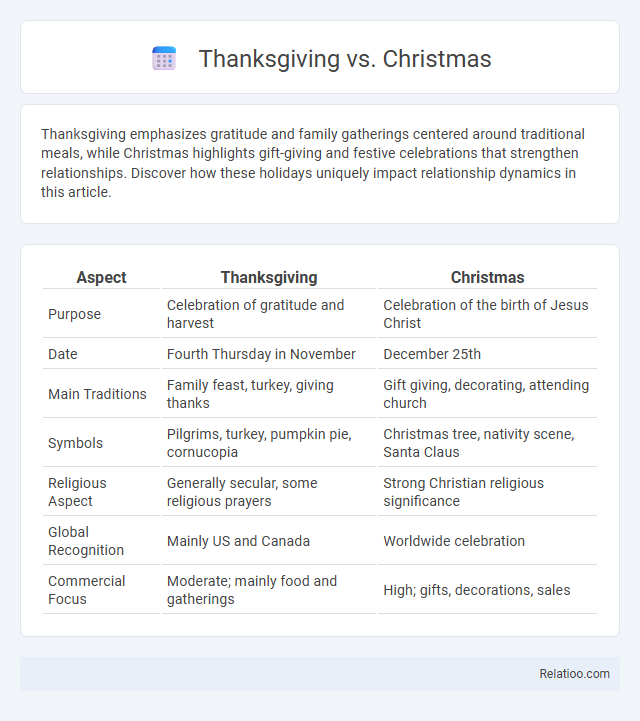Thanksgiving emphasizes gratitude and family gatherings centered around traditional meals, while Christmas highlights gift-giving and festive celebrations that strengthen relationships. Discover how these holidays uniquely impact relationship dynamics in this article.
Table of Comparison
| Aspect | Thanksgiving | Christmas |
|---|---|---|
| Purpose | Celebration of gratitude and harvest | Celebration of the birth of Jesus Christ |
| Date | Fourth Thursday in November | December 25th |
| Main Traditions | Family feast, turkey, giving thanks | Gift giving, decorating, attending church |
| Symbols | Pilgrims, turkey, pumpkin pie, cornucopia | Christmas tree, nativity scene, Santa Claus |
| Religious Aspect | Generally secular, some religious prayers | Strong Christian religious significance |
| Global Recognition | Mainly US and Canada | Worldwide celebration |
| Commercial Focus | Moderate; mainly food and gatherings | High; gifts, decorations, sales |
Introduction: Thanksgiving vs Christmas
Thanksgiving and Christmas both center around family gatherings, yet they highlight distinct traditions and cultural significance. Thanksgiving emphasizes gratitude and sharing a meal, often focused on historical roots and harvest celebrations. Christmas combines religious festivities with gift-giving, creating a unique blend of spiritual reflection and joyful family bonding that shapes Your holiday experience.
Historical Origins of Thanksgiving and Christmas
Thanksgiving originated in 1621 as a harvest celebration between Pilgrims and Native Americans, marking cooperation and gratitude during early colonial America. Christmas traces back to 4th-century Christian traditions commemorating the birth of Jesus Christ, blending religious ceremonies with pagan winter solstice festivities. Both holidays have evolved into culturally significant family gatherings, symbolizing gratitude and togetherness across diverse societies.
Cultural Significance of Both Holidays
Thanksgiving celebrates gratitude and harvest with roots in American history, emphasizing family gatherings and traditional meals like turkey and pumpkin pie. Christmas holds profound religious and cultural significance worldwide, commemorating the birth of Jesus Christ and inspiring festive customs such as gift-giving, decorations, and community celebrations. Your understanding of these holidays highlights their unique roles in fostering family unity and cultural heritage.
Family Traditions During Thanksgiving and Christmas
Family traditions during Thanksgiving and Christmas play a vital role in strengthening your family bonds through shared experiences. Thanksgiving often centers on gratitude rituals and festive meals featuring turkey, while Christmas traditions include decorating trees, exchanging gifts, and celebrating with festive music. These unique practices create lasting memories and foster a sense of belonging that enriches family connections year after year.
Food and Festive Celebrations
Thanksgiving centers around hearty dishes like roasted turkey, stuffing, and pumpkin pie, emphasizing gratitude and harvest celebrations. Christmas features festive foods such as ham, gingerbread, and eggnog, paired with traditions like gift-giving and decorated trees. Both holidays foster family gatherings, creating warm, communal atmospheres filled with joy and shared meals.
Popular Symbols and Decorations
Thanksgiving's popular symbols include pumpkins, cornucopias, and turkey, representing harvest and gratitude, while Christmas features Christmas trees, wreaths, and ornaments that evoke festivity and joy. Family gatherings during these holidays are often centered around decorative elements like autumn leaves and candles for Thanksgiving, and string lights and stockings for Christmas. Your celebrations can be enriched by incorporating these iconic decorations that highlight the unique spirit of each holiday.
Gift-Giving: Christmas vs Thanksgiving
Christmas gift-giving involves a wide tradition of exchanging presents, often emphasizing thoughtful, personalized, or luxurious items, reflecting the season's spirit of generosity. Thanksgiving, by contrast, centers around gratitude and sharing meals, with gift-giving being less common and more symbolic, such as homemade treats or small tokens. Family gatherings during both holidays highlight the importance of connection, but Christmas gifts often reinforce bonds through tangible expressions of care.
Religious and Secular Perspectives
Thanksgiving centers on gratitude and historical reflection, often celebrated in a secular manner with family meals, while Christmas incorporates both religious observance of the birth of Jesus Christ and widespread secular customs like gift-giving and decorations. Religious perspectives on Christmas emphasize worship, nativity scenes, and church services, whereas Thanksgiving's religious roots involve prayers of thanks without formal liturgical practices. Family gatherings serve as a unifying element in both holidays, blending sacred traditions and secular celebrations that strengthen social bonds and cultural heritage.
Major Differences in Festivities
Thanksgiving centers around a harvest feast with traditional foods like turkey, stuffing, and pumpkin pie, emphasizing gratitude and family togetherness. Christmas celebrations often include decorating trees, exchanging gifts, and festive lights, highlighting religious and cultural traditions with broader community involvement. Your experience of these holidays differs as Thanksgiving focuses on a single-day communal meal, while Christmas spans multiple days with diverse activities and rituals.
Which Holiday Resonates More Today?
Thanksgiving centers on gratitude and gathering, emphasizing shared meals and appreciation of abundance, while Christmas highlights generosity, tradition, and the joy of giving through festive decorations and gift exchanges. Family remains a core element in both holidays, serving as a unifying theme that strengthens bonds and creates lasting memories. Your connection to either holiday often depends on personal values and cultural significance, shaping which celebration resonates more deeply in today's fast-paced world.

Infographic: Thanksgiving vs Christmas
 relatioo.com
relatioo.com